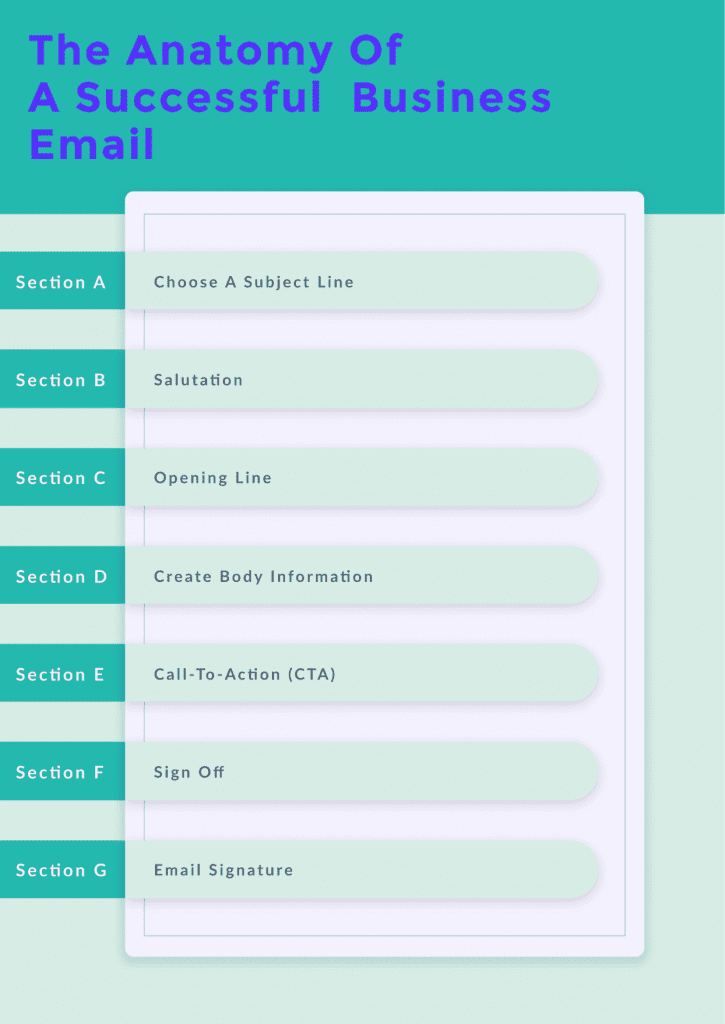The first email was sent back in 1971 and the tool has grown exponentially as a means of communication ever since.
It’s still a challenge to be able to craft the perfect email to a person you want to approach about business or work, though.
To help you write an email that’s perfectly on-point so you can develop relationships and grow your business, we’re going to look at:
- Getting your email started well
- Writing great copy for the body of your email
- What makes a strong call-to-action (CTA)
- How to finish up your email professionally
With plenty of examples along the way.
Let’s get right to it.
Link building cheat sheet
The Anatomy of a Successful Business Email
When did you last receive a really good email?
Maybe you didn’t stop to think about what made it so great at the time, but we reckon it will have contained some key characteristics.
From an aesthetic perspective, it probably looked a little something like our sample email, here:

An opening line, a strong body text that shows exactly what the email is about, a call-to-action (CTA) to ensure you get what you need from the email, and a sign off to round things up.
Before you go hitting that send button, here’s our guide on how to write an effective email for business outreach.
Author’s note: When we give you examples, there will be points where you need to plug in information. When we use {braces}, this signifies variables that you can have Respona populate. When you see [brackets], this is text that needs to be replaced by personalized information.
Step #1: Choose a Subject Line
Getting your email into an inbox and to have someone open the email you send is probably the most challenging thing about sending an email.
One in every six emails will go into the receiver’s spam folder and a lot of that can be due to the subject line.
We’ll look at “spam words” a little further down when we look at the body text of your email – the same words and phrases should be avoided in your subject line so you don’t bounce straight into a Spam folder.
Although it varies by region and by industry, on average only about 22% of emails get opened.

When an email does make it into your inbox, think about how you decide whether to open it – it’s all in a captivating email subject line.
Professionalism is key, which means avoiding spammy or boring words or phrases.
What does that look like? Here’s some best practices to work with.
Best Practices
It’s a topic of great debate in the email marketing world – how long should your subject line be?
According to a study by Backlinko, the ideal length of a subject line is between 36-50 characters long, if you want to get a good response rate.

Use your characters wisely and be specific about the content of your email.
A formal email still needs to have an engaging subject line and a more conversational email needs a chattier one – use the same tone for your subject line as you will for the rest of the email.
Another way to get a good open and response rate for your emails? Personalized subject lines.
The same Backlinko study determined that a personalized email subject line can increase your open rate by 30.5%!
In Respona, you can add a variable into your subject lines so the receiver’s name or company can be added before it’s sent, like in the screenshot below.

By entering information in {braces}, you can have this field filled in with contact information by Respona before your email is sent.
Things to Avoid
As much as you need to be descriptive in your subject line, you don’t want to give the whole game away – give them a reason to click to see the rest of your message.
You probably want to avoid emojis and emoticons in your subject line, even if you’re writing an informal email.
A study by Search Engine Journal found that open rates dropped by around 5% when emojis were used in subject lines in a test covering over 3 million emails.
Don’t over punctuate your subject line either.
Too many exclamation marks don’t go down well with Gmail or other email spam filters.
Let’s look at some examples of subject lines that work.
Example #1: Suggesting a collaboration
Subject: Want to collaborate with us at (company name)?
Example #2: Fixing a broken backlink to your website
Subject: Issue with a link in your (topic) blog post
Example #3: Warming up for a sale
Subject: (Company name) can fix your (pain point) issue
Example #4: Creating your digital network
Subject: Loved your blog post about (topic)
From the subject, let’s move on to the opening sentence.
Step #2: Create Your Opening Line
When you’re not there to give your best handshake, you need to have a great opening line in your email instead.
Your opening line comes straight after your salutation.
Keep your salutation simple, with “Dear Sam,” for a more formal initial email and “Hi Taylor,” when it’s less formal.
Be sure to use the person’s name in your salutation so your email doesn’t look generic.
Your opening sentence should contain exactly who you are, and then use targeted information to explain why you’re emailing.
We’ve already seen how personalization in your subject line can pique interest, so continue that within your opening line – Backlinko’s study suggests you’ll get 32% more responses with personalized content in an email.

Making reference to a success or pain point that you understand within their organization straight off the bat will grab attention.
Here’s some dos and don’ts to look out for.
Best Practices
Be sure that you tell your recipient exactly who you are and why you’re emailing them – you only have their attention for a short time so need to get into details.
Personalization will make a big impression when you write your opening line.
Give at least your first name in your opening line – you would do this when you meet someone in person for the first time, so it fits to do it in this context, too.
Things to Avoid
As with all business communication, don’t get too personal when you’re first reaching out to someone – a reference to a recent promotion that was shared on LinkedIn is ok, but maybe avoid noting their recent holiday snaps that were posted on Facebook.
Time for some examples of good opening sentences.
Example #1: Working with a large corporation
Subject: Subject
Dear {contact name},
It’s [your name] from [company], writing to discuss working with {their company} on our new product that’s about to launch.
Example #2: Giving a blogger a sneak peak at your product
Subject: Subject
Hey {contact name},
[Your name] over at [your company] here. I want to make your {day of the week} even better by giving you an exclusive look at our [new product or service].
Example #3: Promoting an infographic to a news site
Subject: Subject
Hi {contact name},
I’m [your name] from [company]. I was reading your recent story about [story topic] and thought a recent infographic we created would fit right in.
Example #4: Suggesting to appear on a podcast
Subject: Subject
Hey {contact name},
It’s [your name] with [company]. Everyone over here loves your {podcast title} podcast and I thought it’d be cool to get our CEO on with you.
That’s the opening line dealt with, let’s move on to what comes next.
Step #3: Create Your Email Body
Now you’ve got your reader hooked in after a killer opening line, it’s time to get into details.
The body copy of email messages needs to be clear and succinct, and get to the point!
No one has time to read lines and lines of information, so your email body needs to be short and snappy.
According to research, the optimum email length that gets responses is between 75-125 words.
When looking at marketing emails, there’s data that says that emails with 20 lines of text will have the highest click through rates, as you can see in the graph below.

We’re looking at outreach emails and making personal contact with business people, rather than marketing, but it’s worth bearing the data in mind when crafting your email.
What do you write in the body of your email?
Cover the salient points you’re trying to make, whether that’s telling the reader how you want to help their business or explaining what actions you want them to take and why.
Bullet points is an email formatting tool that can help keep your thoughts organized and easy to digest for the reader.
Let’s look at what you should and shouldn’t be doing in more detail.
Best Practices
Personalizing an email can make all the difference when it comes to engaging your reader.
When you get an email from someone who refers to you or your business – a success you’ve had or a post you’ve recently published – you give it more attention than something that’s a bulk email or a copy/paste job.
You can use an email template for your business email, but be sure to plug in variables that allow you to target a sentence or two directly at the recipient.
Use a spam check tool to check your text over for the words we’ve looked at, such as the one in Respona which gives the following information:

As well as keeping your words clear and simple, maintain an easy-to-read, flowing text.
It’s ok to use formatting such as:
- Italics
- Bold
- Underlining
To place emphasis on the most important one or two points, but don’t go overboard otherwise your email will start to look messy.
If you really want to get into the detail of how to format your email body text, you should adjust your line spacing to 1.3-1.5 whilst the optimum font size tends to be 12 or 14.
Things to Avoid
Your email will be scanned for spam content before it even lands in your recipient’s inbox, so you want to avoid using words or phrases that are commonly filtered out.
This table is a good starting point for language you want to avoid at all costs in your email body text.

Just like with your subject line, avoid excessive use of emoticons or punctuation.
Exclamation points have a place in the body of your email, but think about how you would say the sentence out loud.
If your tone of voice wouldn’t be particularly excited, an exclamation point is probably unnecessary.
Finally, avoid poor spelling and grammar.
Be sure to proofread the body of your email for typos and errant capital letters, and consider using tools to do extra checks, such as Grammarly.
Here are some examples to see what your text could look like.
Example #1: Connecting with an industry leader
Subject: Subject
I saw that you recently won [industry award] and wanted to drop you a note to say congratulations.
The work that you’ve been doing [insert a brief summary of the work their department or company has been doing through reading blog posts or LinkedIn research] has been really inspiring.
It’s great that our industry has people committed to really making a change.
Example #2: Offering your new product to a company
Subject: Subject
Our newly launched [product name] is perfect for the {industry type} industry. It’s designed to fix your pain points, such as:
-[Pain point 1]
-[Pain point 2]
-[Pain point 3]
I think it’ll be a great solution for your business to try.
We’re currently running [promotion] and I’d love for you to get on board.
Example #3: Requesting a missed backlink opportunity
Subject: Subject
I was reading your blog about [blog topic] this morning and loved when you said [quote or paraphrase from content].
Super flattered to see you mention us over at [company name] in the piece too.
To help your readers get even more value from your content, I wanted to ask you insert a link back to our page:
[url for backlink]
Example #4: Requesting to place a guest post
Subject: Subject
The work you do on your blog at {their company} is really interesting.
I loved your recent piece, [blog title], and really appreciated when you pointed out [important insight in blog post].
Our blog covers similar topics and I’ve been working on recent ideas like:
-[Suggested blog title 1]
-[Suggested blog title 2]
-[Suggested blog title 3]
And thought one of them would fit great on your blog as a guest post.
Moving on to making your call-to-action.
Step #4: Add a Call-to-Action (CTA)
After making your pitch to your reader, it’s now time to ask something of them.
Your CTA is the whole purpose of your email and needs to be a simple action that they can take, preferably from within the email, such as:
- Replying to your email
- Clicking on your calendar link to book a meeting
- Connecting on LinkedIn or other social media through an embedded link
- Completing a contact form through a landing page you create
Focus on just one CTA; too many options and you’ll not only confuse your reader but start eating into your ideal word count.
The best email format for a personal connection is plain text-based – an image email can look like marketing and we’re looking to make a real business connection – so adding a text hyperlink is the simplest way to have your email recipient take an action.
What are the things that you should do and things to steer clear of?
Best Practices
Include an active verb as part of your CTA, so your receiver will know exactly what to do after they’ve read the great copy you’ve put together.
Examples of active verbs that should get them to take an action include:
- Choose
- Send
- Connect
- Book
- Read
Make your CTA easy – it should take one click for your reader to know what to do, anything more and you start to lose the recipient’s attention.
Things to Avoid
When using an external link in your professional outreach email, don’t overdo it.
We recommend using no more than three links throughout your email, so if you’re linking back to your recipient’s blog or website and your own, then consider if you need to include a calendar link when a simple request for a reply would work just as well.
Having your CTA fade into the background visually isn’t a great idea – highlight it by changing the font color so it stands out from the rest of the text, like this:

Some examples will help.
Example #1: Getting a reply
Subject: Subject
Feel free to get back to me and let me know your thoughts.
Example #2: Booking a call
Subject: Subject
Here’s my calendar link:
[insert calendar link]
If a certain time works for you, it’s all yours :)
Example #3: Making a connection
Subject: Subject
Let’s stay in touch! Here’s my LinkedIn:
[insert LinkedIn profile]
I look forward to learning from each other and possibly collaborating
Example #4: Clicking on a link
Subject: Subject
Sounds good, right? Head over to our info page [hyperlink landing page over text] so we can get your details and arrange for a demo call.
Let’s finish up your business email in the right way.
Step #5: Add Your Email Sign Off
This part of the email is the last thing your recipient will read and needs to match the rest of the email in tone.
There are lots of ways you finish up your email, whether you’ve gone for a corporate, formal style or a more personable messaging, style there’ll be a sign off for you.
You also need to be sure to optimize your professional email signature; this says a lot about your and your business.
As well as having your company name and traditional contact information like your phone number, consider adding your professional social media buttons for LinkedIn, Instagram, Twitter, etc.
Here are some useful rules of thumb for you.
Best Practices
When signing off a proper business email, you need to try and match the tone of the person you’re contacting.
If you’re emailing people in creative industries or who post jokes and memes on their business page, you should be safe to use relaxed email closings.
When contacting a person in a corporate environment, you should pitch your closing remarks to the formal end of the scale.
Even in an informal email, leave your full signature so that your social buttons are there along with your full name so you can be Googled.
It’s becoming more common for people to add their pronouns to their professional email signature, which will ensure that no one will misgender you.
Things to Avoid
There are some well-known phrases in the world of business that are seen as passive-aggressive or plain rude.
Clearly, you don’t want to use these!
Some examples of what to avoid at all costs would be:
- I trust this clears everything up
- I await your response
- Thanks in advance
Even “Best” is debated as to whether it’s short and sweet or rude and blunt, so use it with caution.
Examples are coming right up.
Example #1: The formal sign off
Subject: Subject
Looking forward to working with you in the future.
Best regards,
[Your email signature]
Example #2: The semi-formal sign off
Subject: Subject
Chat with you soon,
[Your first name]
[Your email signature]
Example #3: The informal sign off
Subject: Subject
Can’t wait to start working with you!
[Your commonly used name]
[Your email signature]
Example #4: The neutral sign off
Subject: Subject
Sincerely / Respectfully / Regards,
[Your email signature]
That’s everything in this business email example, let’s check out the next step.
Step #6: Send a Reminder Email
Even a perfectly written contact in the proper business email format might go unanswered.
Roughly 91% of business emails are read within 24 hours of being received and are replied to within that time period.
Even with that, we recommend that you should follow up your first email three to five working days after your first contact.
Your follow up email should follow a similar structure as the initial contact you made, although having two emails – one for those who read and didn’t respond and those who haven’t yet read your initial email – will be most effective.
We’ve got some guidelines on how to handle the follow up.
Best Practices
When you’re doing a follow up email when your first one was read and didn’t get a reply, you don’t need to go over your proposition again.
What you can do is consider offering something of value to the person you’re emailing to gain their attention.
Nothing of clear value to offer?
Professional flattery can work – find a way that your prospective contact has added value or influenced you and your business in some way and tell them about it.
If the first email went unread, you need to strengthen your subject line by checking it for spammy words and making sure you really hit the point in around 50 characters.
Continue to follow up – in the same piece of Backlinko research we’ve referred to earlier, it says that two follow ups definitely increase your overall response rate, as you can see below:

Things to Avoid
Don’t be too eagre with your follow up.
Although if an email is going to get a response, it’s usually within a day, that doesn’t mean you should be back in someone’s inbox too quickly.
You should also know when to quit; sending too many follow ups can come across as annoying.
Now for some examples.
Example #1: Follow up when the first email wasn’t read
Subject: Loved your (blog title) blog, add a link?
Hi {contact name},
Just checking back in case my last message fell through the cracks :)
We’ll share the article across our socials with [combined audience number] followers once it’s in there.
Looking forward to hearing from you!
[Your name]
[Your email signature]
Example #2: Follow up when the first email was read
Subject: Re: (original email subject line)
emailHi {contact name},
[Your name] here, following up from my email last week about [previous email topic].
How does our offer to collaborate sound?
I’d love to send over a goodie bag along with some samples.
Let’s jump on a call so I can grab your details and tell you more, here’s my calendar link:
[Calendar url]
Chat soon,
[Your name]
[Your email signature]
That’s the whole process of writing a professional business email done; let’s wrap this up.
Link building cheat sheet
Now Over to You
We’re all done with writing professional email communications.
Think of your B2B outreach email as the modern version of a business letter to help you stick to a professional email format.
Start with a subject line which will avoid the spam folder, go for a strong opening and follow our email tips to get your body text on point.
Before you hit the send button, finish up with a clear CTA and a sign off that includes a professional email signature.
You want to follow up a few days later if you get no response and work on adding value in your second contact.
How do your business emails look?
Let us know if you’re using any of this advice at the moment and how it’s working out for you.








